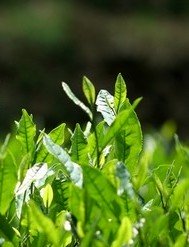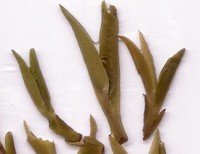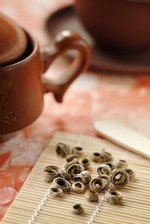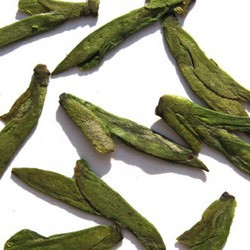Solving problems every tea drinker faces.
Exclusive subscriber benefits:
Receive four FREE quality ebooks worth $60
-
Save at least $5 during your first purchase
It may come as a surprise to you, but the finest Chinese and Japanese green tea – Longjing and Gyokuro – may contain as much caffeine as black tea.
Many experts claim that green tea contains less caffeine than black tea. They assume that the oxidation process increases caffeine. Green tea, being unoxidised, should contain less caffeine than black tea.
Well, that is a myth...
Oxidation does not increase caffeine. In fact, some unpublished studies have found that it reduces caffeine slightly.
So what led to the observation that "black tea has more caffeine than green tea"?
Plant Variety
 Tea plant Camellia sinensis has two
sub varieties: the Chinese Sinensis and
the Indian Assamica.
Tea plant Camellia sinensis has two
sub varieties: the Chinese Sinensis and
the Indian Assamica.
The Indian variety is a fast growing tree with large and broad leaves. It grows most of the black tea consumed in the West.
The Chinese variety is a slow growing shrub with small and narrow leaves. It grows green tea consumed worldwide.
The Chinese variety has less caffeine than the Indian variety. It is the plant variety, not oxidation, that causes most black tea to have more caffeine than green tea.
Leaf Age
Properly speaking, green tea is a bud tea, as supposed to a leaf tea.
Early spring crops yield the youngest, fattest and sweetest tea shoots used exclusively for making the highest grade green tea.
See the picture to the right? They are what we call "one-bud-two-leaves". The bud is in the center. It is surrounded by two slightly unfurled leaves.
 According to a
study, the bud and first leaf contain 5% of caffeine in dry weight, second leaf
3.5%, upper stem 2.5% and lower stem 1.4%.
According to a
study, the bud and first leaf contain 5% of caffeine in dry weight, second leaf
3.5%, upper stem 2.5% and lower stem 1.4%.
Put another way, the younger the tea shoots, the higher the grade, the higher the green tea caffeine content. Black tea is made from mature leaves that contain less caffeine.
This means that high grade green tea can have as much caffeine as black tea, and sometimes even more.
Theanine Decaffeination
If high grade has higher green tea caffeine content, does it mean we should avoid drinking it?
Not at all.
Why? Because two very special compounds are also present in highest concentration: EGCG and theanine.
EGCG bind with caffeine in hot water to render it harmless. Theanine promotes calmness and relaxed awareness. So you get the best of all worlds: theanine, EGCG and caffeine, all combined in optimum proportion.
Scientific studies performed using electroencephalography discovered that theanine decaffeinates tea naturally. If about 8 times as much of theanine is given than caffeine, the effects of caffeine is completely blunted.
High Grade Green Tea
What's the difference between a high and low grade green tea?
A high grade is picked during the first few days of spring. They consist of tea buds rather than matured leaves.
The Chinese people discovered it hundreds of years ago. These tea buds are known to possess great healing power and are the most prized collection of tea plant.
The best way to avoid green tea caffeine content side effects? Try a high grade green.
 Imagine you are sipping the best green tea in the world.
Imagine you are sipping the best green tea in the world.
Despite being a long time drinker of green tea, you are completely blown away. Never have you tasted something so fresh and full bodied, lightly floral and yet flavorful.
No matter what water temperature you use, the tea is always sweet and never bitter.
2-3 glasses mid morning leave you completely relaxed and energized for the day. Your palate feels very clean, silky and refreshed all day long. Your mind feels calm and concentrates very well with whatever task at hand.
This tea is called Tribute Dragon Well Tea. It is grown in the Lion Peak Mountain of Hangzhou, China. The Chinese White House - Zhong Nan Hai - sources 500 kilograms this tea yearly.
You can now buy this tea from this site at 100% purity.
Launched in 2006, she has accumulated nearly 170 raving reviews. Customers are saying that this is the best green tea they have ever had!
New! Comments: Like This Story? Leave A Comment!
References
Upton Tea Imports. Tea and caffeine. http://uptontea.com/shopcart/information/INFOnl_V13N1_Article_page1.asp
Bokuchava MA, Skobeleva NI (1980). The biochemistry and technology of tea manufacture. Crit Rev Food Sci Nutr. 1980;12(4):303-70.
Related Articles
What is the theanine amounts or content per cup? Which tea contains the highest level? What are the health benefits?
References
Desai MY, Armstrong DW (2004). Analysis of derivatized and underivatized theanine enantiomers by high-performance liquid chromatography/atmospheric pressure ionization-masss spectrometry. Rapid Commun Mass Spectron. 2004; 18(3): 251-6.
Kakuda T, Nozawa A, Unno T, Okamura N, Okai O (2000). Inhibition effects of theanine on caffeine stimulation evaluated by EEG in the rat. Biosci Biotechnol Biochem. 2000 Feb; 64(2): 287-93.
Back to Top of Green Tea Caffeine Content
Back to Green Tea Caffeine Main Page
Back to Amazing Green Tea Home
Solving problems every tea drinker faces.
Exclusive subscriber benefits:
Receive four FREE quality ebooks worth $60
Save at least $5 during your first purchase
Copyright� 2006-2025 Amazing-Green-Tea.com. All rights reserved.

